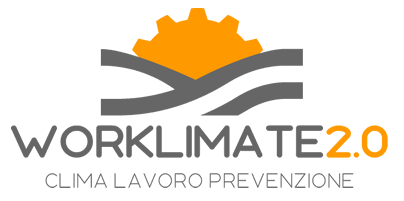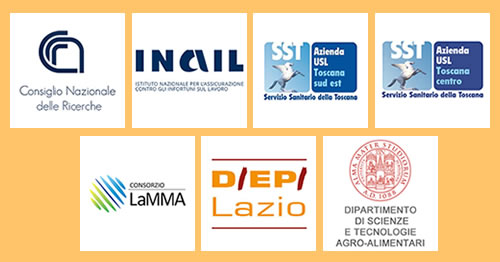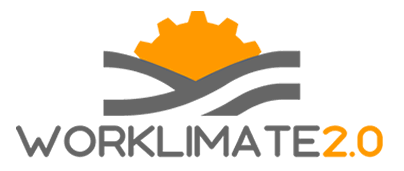
PROTOTYPE HEAT STRESS FORECASTING SYSTEM FOR THE INITIAL SCREENING OF RISKS AMONG OUTDOOR WORKERS
Experimental activity for use by workers, employers occupational safety and management professionals.
In consideration of the typical conditions of the autumn-winter period, the personalized heat risk forecasts for workers are currently suspended and will resume in the
spring 2024.
Heat risk predictions for various worker profiles
Heat risk forecasts based on the “anti-heat” ordinance in force in some Italian regions
Forecasts of the areas where is possible the exceedment of the daily temperature threshold of 35°C
Heat risk predictions for various worker profiles
Mappe nazionali di previsione del rischio caldo, basate sul modello meteorologico BOLAM (risoluzione a 7 km) e valide per alcuni profili di lavoratori non acclimatati al caldo, sviluppate sulla base di un indicatore utilizzato nel settore occupazionale e selezionato nell’ambito del progetto (Wet Bulb Globe Temperature, WBGT).
Experimental and automatic (uncontrolled) forecasts based on meteorological models are affected by intrinsic uncertainty and can be significantly different from real conditions. Forecasts should therefore be considered as a decision support tool to integrate existing tools and weather-climate observation accomplished directly in the workplace.
Le mappe mostrano la previsione del rischio caldo fino a tre giorni, per quattro momenti della giornata corrispondenti alle ore 8, 12, 16 e 20.
THE INFORMATION RELATES TO A HEALTHY WORKER, NOT ACCLIMATISED TO HEAT, EXPOSED TO DIRECT SUN OR SHADE AND ENGAGED IN INTENSE OR MODERATE OUTDOOR PHYSICAL ACTIVITY.
Moderate physical activity includes:
- Upper limb activities (hammering nails, filing)
- Driving off-road trucks, tractors or construction machinery
- Working with the upper body (pneumatic hammer work, tractor assembly, plastering, intermittent handling of moderately heavy material, weeding, hoeing, picking fruit or vegetables)
- Pushing or pulling light carts or wheelbarrows
- Walking at a moderate speed (3.5 and 5.5 km/h)
- Laying bricks
- Assembling vehicles
Intense physical activity includes:
- Physically intensive upper body activity; carrying heavy material
- Work requiring the use of axes or shovels for shoveling or digging at an intense pace
- Working with a hammer
- Sawing, planing or chiselling hard wood
- Hand mowing, digging
- Walking at a speed between 5.5 and 7.0 km/h
- Pushing or pulling wheelbarrows and barrows with heavy loads
- Arranging concrete blocks
- Repeatedly climbing steps or ladders
Heat risk forecasts based on the “anti-heat” ordinance in force in some Italian regions
Forecast of heat risk based on some regional ordinances which, based on the BOLAM meteorological model (7 km resolution), indicate the prohibition on carrying out work in the agricultural sector between 12:30 and 16:00 , limited to days in which the heat risk is “HIGH” (it is referred to a healthy worker -without individual conditions of thermal susceptibility-, not acclimatized to the heat, exposed to the sun at 12:00 and engaged in intense physical activity).
Experimental and automatic (uncontrolled) forecasts based on meteorological models are affected by intrinsic uncertainty and can be significantly different from real conditions. Forecasts should therefore be considered as a decision support tool to integrate existing tools and weather-climate observation accomplished directly in the workplace.
INDICATE THE LOCATION IN WHICH THE 5-DAY FORECAST OF THE HEAT RISK FOR A HEALTHY WORKER (WITHOUT INDIVIDUAL THERMAL SUSCEPTIBILITY CONDITIONS), NOT ACCLIMATED TO THE HEAT, EXPOSED TO THE SUN AT 12:00 AND ENGAGED IN INTENSIVE PHYSICAL ACTIVITY.
FORECASTS OF THE AREAS WHERE IS POSSIBLE THE EXCEEDMENT
OF THE DAILY TEMPERATURE THRESHOLD OF 35°C
Experimental and automated (uncontrolled) forecasts based on meteorological models are affected by intrinsic uncertainty and can be significantly different from real conditions. Forecasts should therefore be considered as a decision support tool to integrate existing tools and procedures and weather-climate observation carried out directly in the workplace.
National forecast maps of the possible theair temperature 35 °C threshold exceedances based on the MOLOCH meteorological model (2.5 km resolution).
i partner


contatti
Marco Morabito
Consiglio Nazionale delle Ricerche, Istituto per la BioEconomia
(CNR-IBE)
marco.morabito@ibe.cnr.it
Alessandro Marinaccio
Inail, Dipartimento di Medicina, Epidemiologia e Igiene, Laboratorio di Epidemiologia
(Inail, Dimeila)
a.marinaccio@inail.it
Michela Bonafede
Dipartimento di Medicina, Epidemiologia e Igiene, Laboratorio di Epidemiologia
(Inail, Dimeila)
m.bonafede@inail.it
Informativa Privacy
